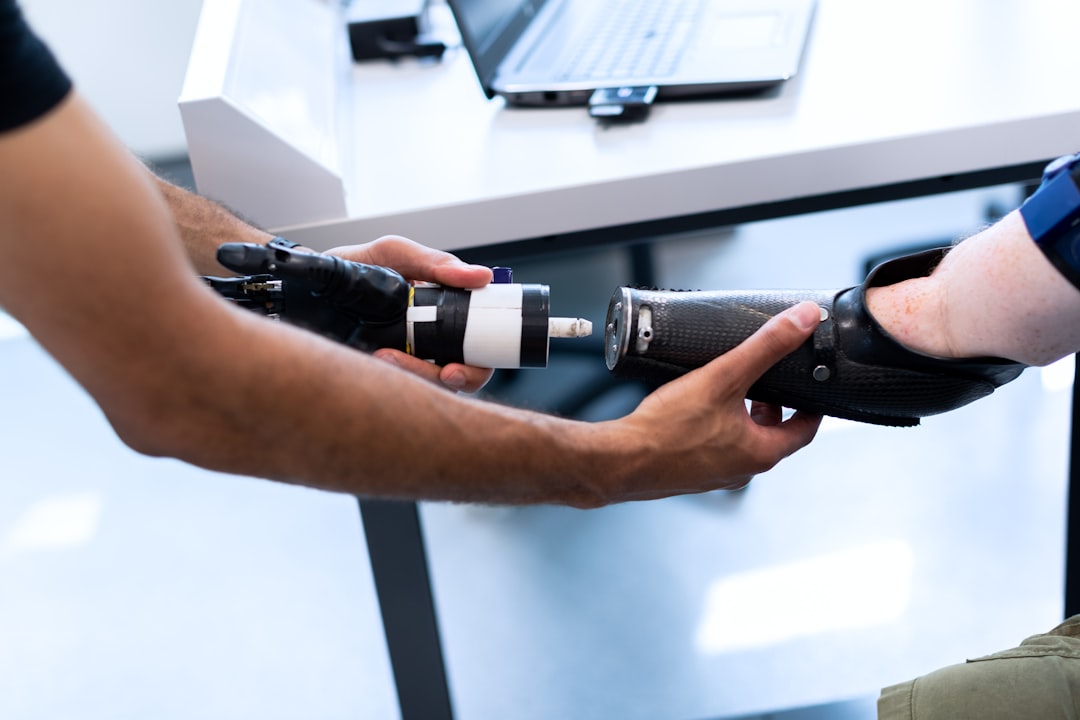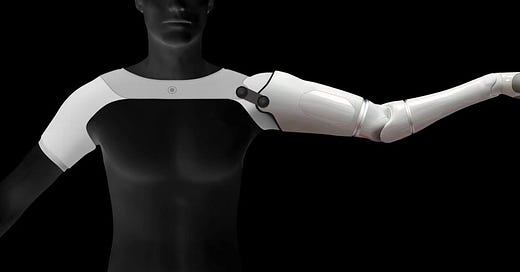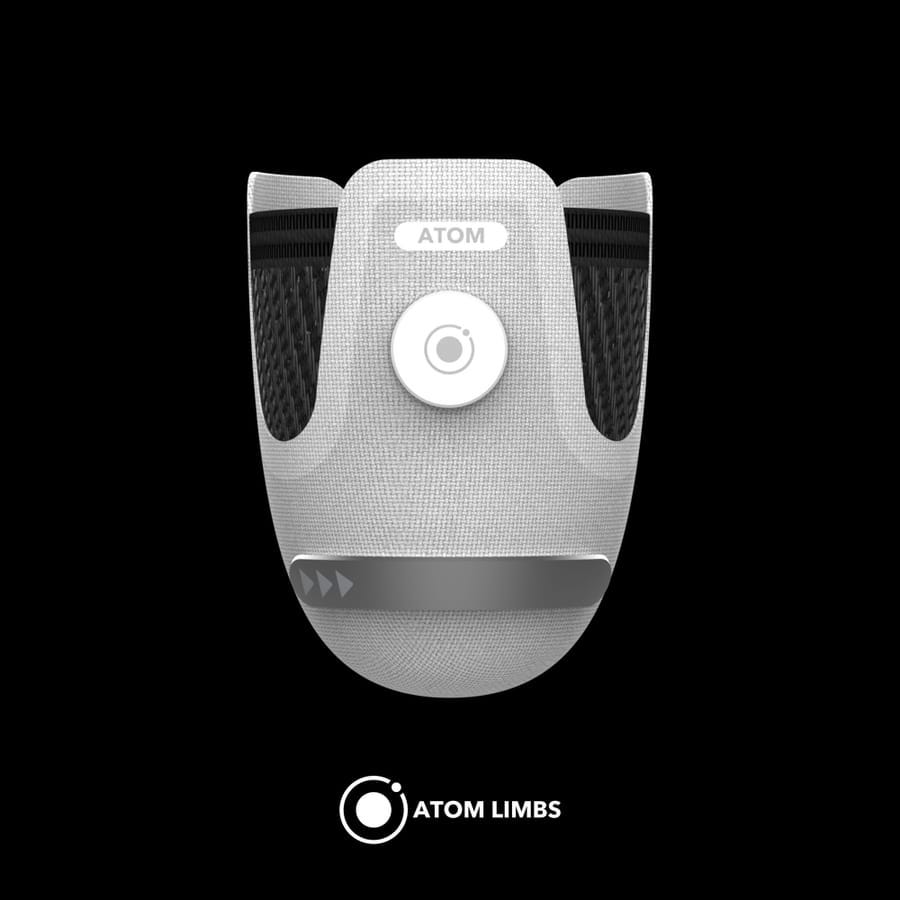Year 2049 is a weekly newsletter that explores the innovations and discoveries shaping our future through comics.
If this was forwarded to you, subscribe for free to get a new story in your inbox every Friday.
Today’s Edition
Comic: Mateo gets a new prosthetic arm
Story: Atom Limb wants to create the next generation of prosthetics
Update: Ossiform’s scientific paper on its 3D-printed bone implants
Quote: Marie Curie on fear
Comic
Story: Atom Limbs 🦾
Prosthetics still need improvements

Millions of people worldwide live with some type of limb amputation and their options for prosthetics are sometimes limited.
Even more advanced prosthetics have problems.
A recent study conducted on 68 traumatic upper limb amputees found that 44% had abandoned their prosthetics. Even more surprising: there was no significant difference in prosthetic acceptance between responders amputated before or after 2006.
The advancements of the last decade in the arena of upper limb prosthetics have not yet achieved a significant change in prosthetic abandonment within this study cohort. Although academic solutions have been presented to tackle patient's complaints, clinical reality still shows high rejection rates of cost-intensive prosthetic devices.
Source: Current rates of prosthetic usage in upper-limb amputees - have innovations had an impact on device acceptance? (PubMed.gov)
What’s wrong with prosthetics?
I’ve tried my best to read as many research findings and anecdotes from people who have used prosthetics. I was lucky to come across Britt Young’s eye-opening piece in Input Mag. Here are some of the biggest problems I learned about:
Weight: Some prosthetics can weigh over 4 kgs (9 lbs) which makes them uncomfortable to wear all day. Even if that may not sound like a lot, it can be heavy on a limb that doesn’t usually carry any weight.
Control: Some models require you to flex your muscles quickly to cycle through different grip patterns, which can be incredibly frustrating and difficult to use.
Cost: Advanced prosthetics cost at least $30,000 and some models go up to $75,000.
Prosthetic arm technology is still so limited that I become more disabled when I wear one.
– Britt Young
Can Atom Limbs improve prosthetics?
Atom Limbs is combining breakthroughs in robotics, neural interfaces, and AI to bring the first artificial human limb to market. Their goal is to develop products that replicate human limbs as much as possible, starting with the Atom Touch, their version of a prosthetic arm. The Atom Touch is set to be released in 2023.
The first neurally-controlled artificial limb was developed by Johns Hopkins, which received $120 million in funding from the US Department of Defense and DARPA back in 2006.
Johns Hopkins successfully developed the Modular Prosthetic Limb (MPL). Atom Limbs has an agreement in place* with Johns Hopkins to build upon the MPL’s technology and commercialize its products (Atom Limbs doesn’t own the MPL or its IP).
* According to Atom Limbs: Atom Limbs currently has executed an exclusive option agreement with JHU APL and intends to negotiate a licensing agreement.
Johnny Matheny was the first person to ever wear and use the MPL. In 2018, Johns Hopkins gave him the MPL for an entire year to test it out. In an interview with Quartz, John mentioned that he wanted to play the piano by the end of that year (which inspired today’s comic). He was able to play the piano within a few months. I’ve linked the video at the bottom.
Atom Touch: the design and tech
While the Atom Touch looks nice and sleek, what really matters is whether the design and technology can solve the shortcomings of current prosthetics.
The Touch builds upon Johns Hopkins’s $120 million of R&D into the MPL. On top of that, the startup has gathered an Avengers-like roster of leaders, designers, and engineers who previously worked at Apple, Tesla, Nike, and Intel, to take it to the next level.
Let’s examine what they came up with:
Design
Improved comfort and fit: unlike existing prosthetics that use sockets to attach to residual limbs, Atom Limbs developed a shirt-like wearable aimed to increase comfort and fit.
Reduced size & weight: while I couldn’t find the exact weight of the Atom Touch, the CEO stated that it’ll weigh as much as a human arm. It also looks less bulky and robotic than the MPL.
Technology
Neurally-controlled: Like the MPL, the Atom Touch is controlled by the signals your brain sends to your limbs. Don’t worry, no brain implants are required. The Atom Touch is an electromyographic (EMG) prosthetic that uses more than 200 sensors to detect the body’s nerve signals.
AI: Once the EMG band detects the nerve signals, it sends them to the robotic arm, which has built-in AI to convert those signals into movements in realtime. I couldn’t find more details about how this actually works, so I’ve reached out to Atom Limbs to get more clarity because I’m a nerd.
Sense of touch: The Touch will help people feel the touch of objects they're interacting with. I couldn’t find any public information about how this will be done exactly, so this is another thing I’d like to ask Atom Limbs about.
Final thoughts
I’m eager to see how Atom Touch compares to other prosthetic solutions once it’s available to the public. On paper, the design and technological improvements look promising. The feedback from testers seems to be very positive so far:
People love it! The 20 or so folks who used the R&D prototypes reported more functionality, more usefulness, and also more "attachment" — it "felt" more like it was part of their natural body. It was a natural extension.
Everyone is very sad when they have to get the arm taken away from them. So we're working as hard as we can to get the finished product out as quickly as possible.
– Tyler Hayes, CEO of Atom Limbs, in an interview with The Medical Futurist
The biggest question mark around the Atom Touch is the price. If the product solves all the problems that previous prosthetics couldn’t, it would be a shame if the price made it inaccessible to those who need it the most.
I’ll make sure to provide any updates from Atom Limbs in future newsletters.
Deep dive
If you enjoyed the story, I’ve compiled some additional links to satisfy your curiosity:
I have one of the most advanced prosthetic arms in the world — and I hate it (Input) – Highly recommended
The Johns Hopkins Revolutionizing Prosthetics Program (Johns Hopkins)
A much more detailed breakdown of Atom Touch’s design and features (Bionics for Everyone)
Update: Ossiform’s latest scientific paper
Ossiform, the Medtech startup I covered in a previous post, just published a paper on its latest experiments with its 3D-printed bone implants.
In this newly published paper, Ossiform has compared its 3D printed P3D Bone implant with an off-the-shelf b-TCP* implant. The implants were inserted in the mandible ramus of pigs, and after six months, resorption and remodeling were evaluated using CT-scans and histological images.
After six months, the P3D Bone implants were almost completely resorbed and replaced by vascularized compact bone, allowing osteointegration to occur. The histological image in the upper right corner shows the partially resorbed P3D Bone implant only three months after implantation.
– Ossiform
*b-TCP = beta tri-calcium phosphate
You can access the full article here
Quote
Nothing in life is to be feared, it is only to be understood. Now is the time to understand more, so that we may fear less.
– Marie Curie
A timeless quote from the legendary scientist.
It’s normal to feel scared and overwhelmed with the flurry of clickbaity headlines and doomsday predictions about the newest innovations we come across every day.
I hope I’m doing my part in helping you understand these things every week. I’m learning and understanding alongside you.
Let me know if there are any topics you’d like me to cover.
If you missed the previous episode
I spoke about bidirectional charging and its potential to completely reimagine how we store and supply energy.
You can also check out all previous Year 2049 episodes in chronological order to learn about other interesting innovations in climate, transportation, science, food, and more.
How would you rate this week's edition?













Such an important way to help those with these disability. The potential progress that you have highlighted will be totally life changing for them